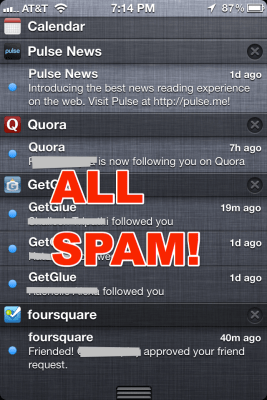Mobile app developers are abusing push notifications and it has to stop. Although it’s widely understood that it’s not an effective strategy to continually ping users with non-critical updates, app developers can’t seem to help themselves to the free marketing channel that is the opt-in push. Continual notifications keep the app at the forefront of users’ minds, entice them to relaunch the app to see what’s new, remind them of something they may have forgotten, and more – or, at least, so the app developer hopes. But it’s a fine line between being seen as useful and friendly versus a source of never-ending message spam.
Push notifications can give a social app an air of popularity it wouldn’t otherwise have the means to display. The phone continually buzzes to indicate how many people are checking out the new app. But there’s only so much showing off a user can take.
Notification that a friend of yours signed up for the service, or left a comment, or “liked” something, or added you or followed you, etc. is very rarely must-have information. It’s not actual news. It doesn’t improve your life to know you have one more follower. It doesn’t deserve the right to pull your attention away from whatever you were doing out there in the real world, which is almost always far more important. While there may be the rare social app where you want to know these things immediately (Facebook perhaps?), in all likelihood, you don’t want to be interrupted with these sorts of updates for every app you install.
That’s just one genre, but social apps are often the worst offender. Beyond social, there are all sorts of push notification types out there. See this list courtesy of Urban Airship:
Entertainment
- New content (items, features)
- Time-sensitive events
- Routine features (word of the day)
Publishing
- Breaking news
- Local alerts
- Reader sweepstakes
- Service messages
- Free trial conversion prompts
- Single-edition to subscription upselling
- Special section or issue highlights
- Local offers
Media
- New content (full episodes, teasers, bonus content etc.)
- Reminders (show times, special appearances, live events)
- Polling (Questions, reminders, results)
- Drive users to other media (mobile site, television program)
Retail
- Ask for Product reviews
- Comments on your reviews and the products you follow
- Product availability/new styles
- Shipping confirmation
- Shipping updates
- Shopping cart expiration
- Deals/sales
- Personal coupons
- Recommendations
- Ask for customer service reviews
- Send branded entertainment/co-op and shopper marketing (video, picture, etc.)
- Push based on location data ie ski gear to people who have been in ski town zip codes ( expand to fit additional sports locations)
Social Networking
- Responses + feedback on posted content
- User interactions
- New content from followed accounts
- Feature updates
- Broadcasts encouraging engagement (new contest, your content has been featured, etc.)
B2B
- New articles
- Real-time support
- Real-time customer service
How many of those items above do you actually think are critical messages? I’ll bet you can count them on one hand. And even then, I’ll bet you have a few qualifiers about how often and when you want to see them.
The problem with push notification abuse is not just that it’s annoying when you’re interrupted by something that has no meaning to you, it’s that it creates an environment where users become suspect of the whole push notification mechanism itself. I’d argue we’re already there. If you’ve said “no” to an app upon first launch when it asks your permission to send push notifications, then you basically agree. Users can no longer trust developers to use the system properly, so we’re opting out of notifications entirely.
That’s a shame because when done well, push notifications can and do work. Urban Airship says that apps following “good” push notification practices can actually more than double the retention rate over a six-month period after download. And the benefits of “good” push grows over time. Good push notifications drive 67% of app usage the first month after download, 74% of usage two months after download, and 81% of usage three months after download, they found.
Good push notifications, in case you’re wondering, are those that are highly relevant to the user and focused on meeting their needs. Remember, that’s the user’s needs, not the app developers’ wants. Only developers care about how often an app is launched, not the user. “We’ve seen time and time again, push notifications that solely serve an app’s or brand’s objectives rather than what is really meaningful can turn people off fast,” said Brent Hieggelke, CMO, Urban Airship. “It has to pass the family dinner test. Push interrupts their lives, so you have to make it worth it.”
So what is a an example of a good push notification? Burton Snowboards is a perfect example, he said. They found a way to engage users with relevant information by offering to push fresh snowfall alerts to customers. Another company might have taken a different approach, like sending a ton of promotional sale messages. This would risk alienating the company’s best customers (“Hey, I already bought the snowboard! Give it a break!”) Instead, Burton builds goodwill and stays relevant by telling customers something useful.
Of course, the hard part is figuring out what a user considers “good.” Seemingly, a Burton Snowboards app user probably does care about fresh powder alerts. But every user is different, and ideally, they should be given more of a choice about what and how often you ping them. There should be controls in every app’s settings for this. And if there’s not, then developers should definitely err on the side of caution here. After all, it’s a lot easier to X an app from the homescreen than it is to toggle a switch deep in the phone’s settings somewhere.
